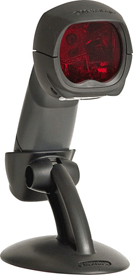 A barcode reader, also called a price scanner or point-of-sale ( POS ) scanner, is a hand-held or stationary input device used to capture and read information contained in a bar code . A barcode reader consists of a scanner , a decoder (either built-in or external), and a cable used to connect the reader with a computer. Because a barcode reader merely captures and translates the barcode into numbers and/or letters, the data must be sent to a computer so that a software application can make sense of the data. Barcode scanners can be connected to a computer through a serial port , keyboard port , or an interface device called a wedge . A barcode reader works by directing a beam of light across the bar code and measuring the amount of light that is reflected back. (The dark bars on a barcode reflect less light than the white spaces between them.) The scanner converts the light energy into electrical energy, which is then converted into data by the decoder and forwarded to a computer.There are five basic kinds of barcode readers -- pen wands, slot scanners, Charge-Couple Device ( CCD ) scanners, image scanners, and laser scanners.
A barcode reader, also called a price scanner or point-of-sale ( POS ) scanner, is a hand-held or stationary input device used to capture and read information contained in a bar code . A barcode reader consists of a scanner , a decoder (either built-in or external), and a cable used to connect the reader with a computer. Because a barcode reader merely captures and translates the barcode into numbers and/or letters, the data must be sent to a computer so that a software application can make sense of the data. Barcode scanners can be connected to a computer through a serial port , keyboard port , or an interface device called a wedge . A barcode reader works by directing a beam of light across the bar code and measuring the amount of light that is reflected back. (The dark bars on a barcode reflect less light than the white spaces between them.) The scanner converts the light energy into electrical energy, which is then converted into data by the decoder and forwarded to a computer.There are five basic kinds of barcode readers -- pen wands, slot scanners, Charge-Couple Device ( CCD ) scanners, image scanners, and laser scanners.
Wednesday, July 9, 2008
Barcode reader
 A barcode reader, also called a price scanner or point-of-sale ( POS ) scanner, is a hand-held or stationary input device used to capture and read information contained in a bar code . A barcode reader consists of a scanner , a decoder (either built-in or external), and a cable used to connect the reader with a computer. Because a barcode reader merely captures and translates the barcode into numbers and/or letters, the data must be sent to a computer so that a software application can make sense of the data. Barcode scanners can be connected to a computer through a serial port , keyboard port , or an interface device called a wedge . A barcode reader works by directing a beam of light across the bar code and measuring the amount of light that is reflected back. (The dark bars on a barcode reflect less light than the white spaces between them.) The scanner converts the light energy into electrical energy, which is then converted into data by the decoder and forwarded to a computer.There are five basic kinds of barcode readers -- pen wands, slot scanners, Charge-Couple Device ( CCD ) scanners, image scanners, and laser scanners.
A barcode reader, also called a price scanner or point-of-sale ( POS ) scanner, is a hand-held or stationary input device used to capture and read information contained in a bar code . A barcode reader consists of a scanner , a decoder (either built-in or external), and a cable used to connect the reader with a computer. Because a barcode reader merely captures and translates the barcode into numbers and/or letters, the data must be sent to a computer so that a software application can make sense of the data. Barcode scanners can be connected to a computer through a serial port , keyboard port , or an interface device called a wedge . A barcode reader works by directing a beam of light across the bar code and measuring the amount of light that is reflected back. (The dark bars on a barcode reflect less light than the white spaces between them.) The scanner converts the light energy into electrical energy, which is then converted into data by the decoder and forwarded to a computer.There are five basic kinds of barcode readers -- pen wands, slot scanners, Charge-Couple Device ( CCD ) scanners, image scanners, and laser scanners.
Subscribe to:
Post Comments (Atom)

No comments:
Post a Comment